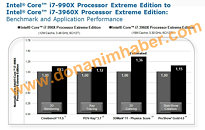Friday, July 22nd 2011

Core i7-3960X About 47% Faster On Average Than Core i7-990X: Intel
Slides of a key presentation to Intel's partners was leaked to sections of the media, which reveal Intel's own performance testing of the Core i7-3960X Extreme Edition, the top-model of the socket LGA2011 "Sandy Bridge-E" processor series. Meet the family here. In its comparison, Intel maintained the Core i7-990X Extreme Edition socket LGA1366 processor as this generation's top offering. It was pitted against the Core i7-3960X in a battery of tests that included some enthusiast favourites such as Cinebench 11.5, POV-Ray 3.7, 3DMark 11 physics, Pro-Show Gold 4.5, and some OEM favourites such as SPECint_rate base2006, SPECfp_rate base2006, and SiSoft SANDRA 2011B multimedia and memory bandwidth.
From these test results, the Core i7-3960X Extreme Edition is pitched to be about 47.25% faster on average, compared to Core i7-990X Extreme Edition. Intel is attributing the performance boost, apart from the normal IPC increase, to the 33% higher bandwidth thanks to the quad-channel DDR3 IMC, and the new AVX instruction set that accelerates math-heavy tasks such as encoding. The Core i7-3960X Extreme Edition is an upcoming socket LGA2011 six-core processor that is clocked at 3.30 GHz, with Turbo Boost speed of up to 3.90 GHz, with 12 threads enabled by HyperThreading technology, and 15 MB L3 cache. It will release by either late 2011 or early 2012.
Source:
Donanim Haber
From these test results, the Core i7-3960X Extreme Edition is pitched to be about 47.25% faster on average, compared to Core i7-990X Extreme Edition. Intel is attributing the performance boost, apart from the normal IPC increase, to the 33% higher bandwidth thanks to the quad-channel DDR3 IMC, and the new AVX instruction set that accelerates math-heavy tasks such as encoding. The Core i7-3960X Extreme Edition is an upcoming socket LGA2011 six-core processor that is clocked at 3.30 GHz, with Turbo Boost speed of up to 3.90 GHz, with 12 threads enabled by HyperThreading technology, and 15 MB L3 cache. It will release by either late 2011 or early 2012.



116 Comments on Core i7-3960X About 47% Faster On Average Than Core i7-990X: Intel
Im staying 1155 and just going Ivy Bridge
but the amount of problems, more cache generates, exceeds the benefits by a lot;)
Turbo mode:
i7 990X = 3.73GHz
i7 3960X = 3.9GHz
It's quite obvious.
By a curbstomp.
From a mech.
Im getting tierd with this. AMD has 2 active sockets for the entire range. FM1 and AM3+.
Intel currently has 3 active sockets and a 4th on the way. 1366 1155 1156 and now 2011.
And thats without mentioning the chipset dance. even if the socket is the same the chipset has to be the correct one...
Please intel. pick 1 socket and make the damn chipsets compatible.
AMD fell into an advancement hole on AM2 so they had no real reason to push out different sockets like Intel did.
This would have to over $2k when it comes out, surely.
i7, seemingly arbitrary numbers, and then a letter.
Is that a quad, a duo, a what? Is it good, is it better, does it make toast?!? And AMD are guilty too. Can I please just get a decent scale over what the fuck is what.
Oh and then there's the whole some iX use this socket, some use that. Can they just use ONE socket for ONE "species" of chip.
Anyway, looking at SB and SB-E side by side, does putting them both in the same package really sound reasonable? No way :pExtreme series CPUs from Intel have always been in a certain price range, don't expect this to deviate too drastically from that.Are we already assuming these clock just like sandy bitch chips? :D
There's been a rumor floating around XS that was first suggested over at [DH] that intel will drop prices on the 2500K/2600K from 219.99 to 199.99 and 314.99 to 289.99 to make way for a 2800K that will be 6 cores with no HT for 349.99 but this is PURELY speculation and i haven't seen any ES of it.Why would it be cherry picked? SB-E is already on B2 steppings. Hell C0 will probably be retail.
And yes you can be limited by a socket, by its # of pins just for vcc and ground for a CPU with so much more TDP is a big deal, add a few more cores, some PCI-E controller, IMC to quadchannel, and so on.
if you notice with LGA1366 intel has a IOH(northbridge) and ICH(southbridge), with LGA2011 and LGA1155 there is only a PCH, like the A75 chipset(called FCH) if you are familiar with AMD.
So AMD is still using a two part chipset, while Intel has moved to all single chipset. These moves, such as the testing of this with LGA1156, and then sticking with two for LGA1366, shows Intel has the ability to heavily modify the substructure other than the cores, while with lets say Phenom 2 they couldn't add an onboard PCI-E controller, they are limited to the NB, same with BD, they have to use that NB, they are also limited to power package, and thus they came out with true AM3+ boards, AM3 board will be limited and so on.
Its a lot of confusion, Intel doesn't bring out new sockets every year.